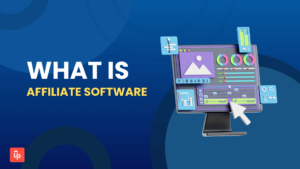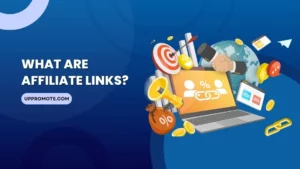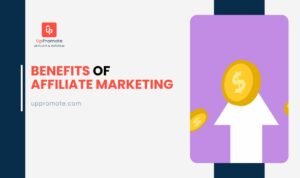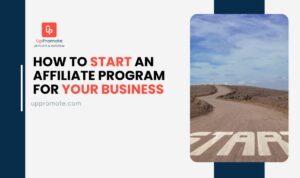If you are a fresh face in the affiliate marketing industry, it is understandable to worry whether you will succeed.
Fortunately, there are many impressive examples of affiliate marketing case study to encourage you to start. As you learn from successful affiliate marketers and their strategies, making money from online businesses does not seem too hard anymore.
This article consists of diverse case studies for your information. It proves how you can make money from affiliate programs, SEO optimization, and the pay-per-click (PPC) model.
So, regardless of your path, these cases will surely inspire your affiliate marketing journey!
Amazon Affiliate Marketing Case Study: The Story of This Is Why I’m Broke
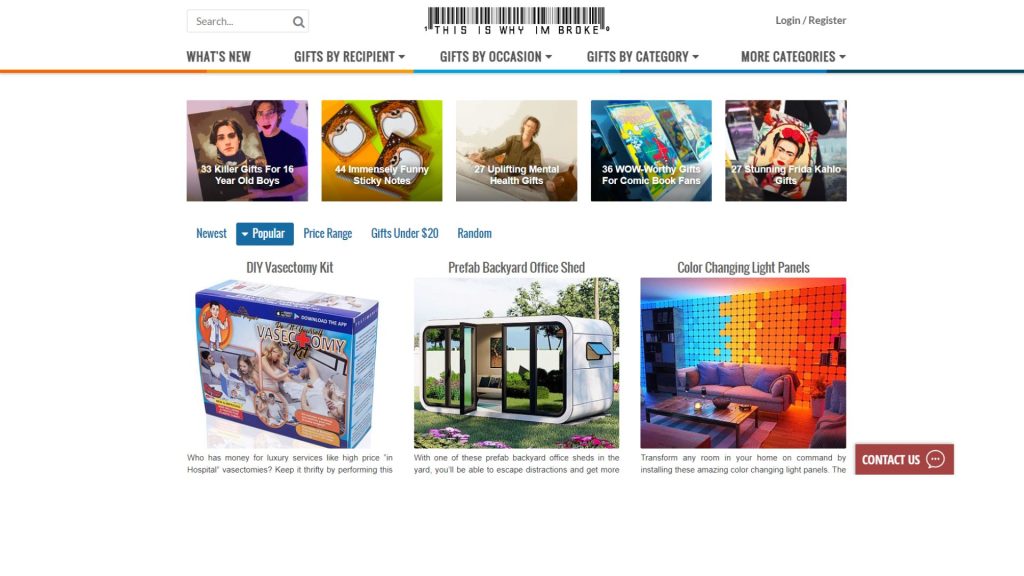
Key Stats
- Earns $20,000+ per month from Amazon, accounting for 66% of total income
- More than 2,800,000 visitors per month
- Facebook: 305,000 followers
- Twitter: 5,236 followers
- Pinterest: 7,358 followers
- G+: 11,388
Note: The above data changes frequently and might be more by the time you read this.
Affiliate Site Explained
This Is Why I’m Broke (TIWIB) is a quirky site sharing cool and unusual products in various categories on the Internet. It is quite a fascinating affiliate marketing case study.
Its broad list of geeky (sometimes useless) items is amusing. You will find a series of unnecessary tools, gadgets, toys, and accessories like the photo below.
A lot of products come from giant retailers like eBay and Amazon. Some are from Etsy, Kickstarters, and niche stores like Firebox and ThinkGeek.
Basically, anything that surprises people with its hilarious appearance and purpose. Geeky lingerie, 1500 live ladybugs, alcohol-infused popcorn—you name it.
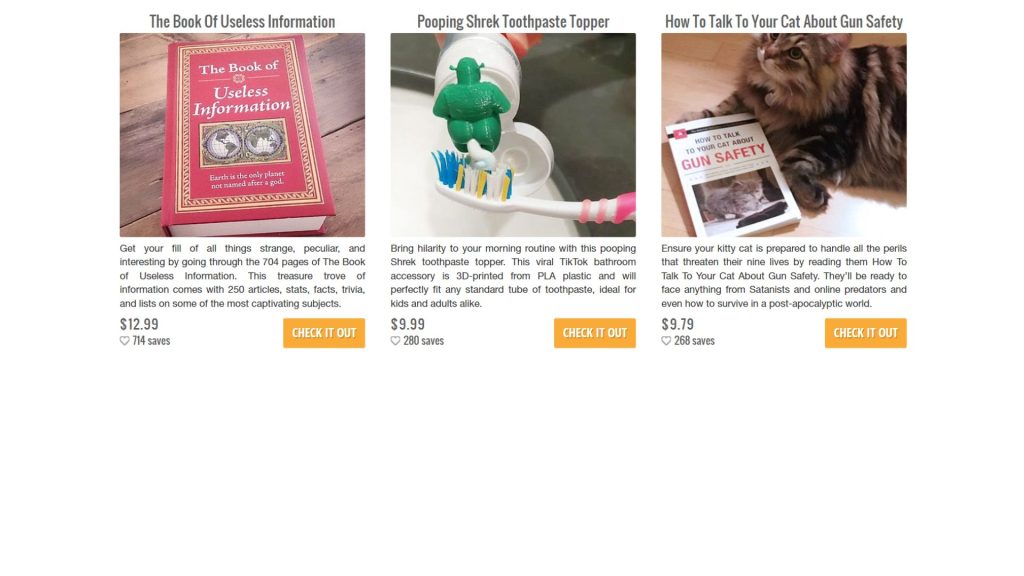
So, what was the initial motive behind this page?
Adam Freedman, the founder, has failed many business plans and had a hard time making money online. Until 2011, when he learned from similar sites and aimed to improve on their experience.
In fact, TIWIB is not the first affiliate page of this type.
But it stands out for leveraging customer experience. Not many sites can engage their visitors with this number of unusual items.
And the amount of wit and humor added to product descriptions is off the roof. It shows true dedication to capturing attention with quality content.
Moreover, TIWIB is a rare affiliate site that utilizes infinite scrolling. Thus, visitors are compelled to look at more and more products as they browse.
How They Make Money
The whole point of TIWIB is to create value instead of getting plain affiliate link clicks.
So, its goal is to sort out and share weird items across different sources. It also focuses on producing funny and engaging content in each product description.
It does that by signing up to the RSS feed of around 100 retailers and blogs. They mainly sell or feature quirky stuff, and TIWIB uses these sources for daily inspiration on its own page.
Not all items are on sale or affiliate products, though. They just have that ‘wow’ factor that deserves to be featured.
You can see that TIWIB is selective and does not display everything it finds slightly weird.
However, the key lies in how this page collaborates with multiple affiliate programs. The list includes Amazon Associate affiliate program, eBay Partner Network, and others like Firebox, Think Geek, Wicked Lasers, etc.
After visitors click on an item here, they are redirected to the retailers’ product page and make a purchase. The page earns commissions for every successful sale.
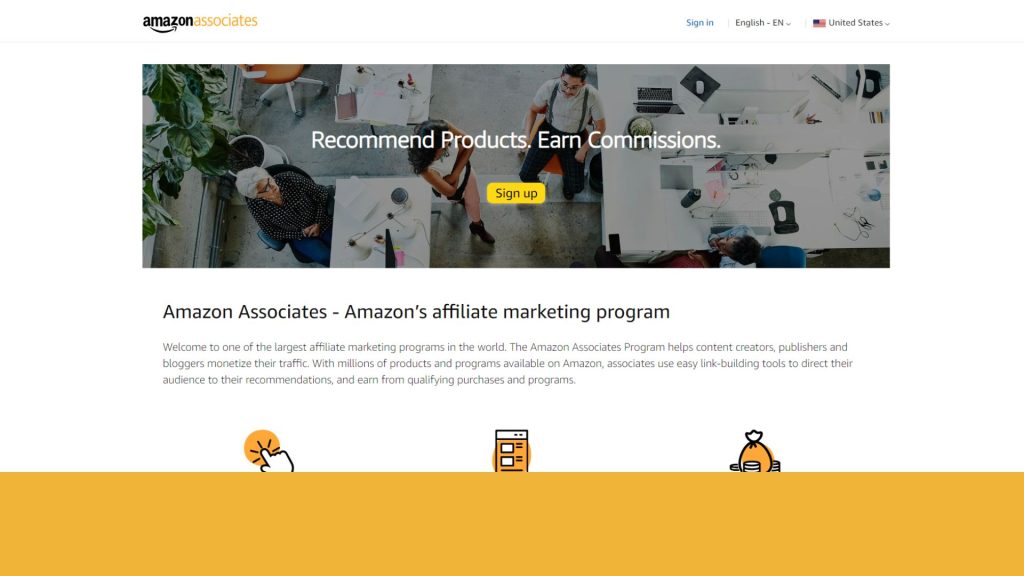
From Amazon alone, this site earns around $20,000+ per month. This number accounts for 66% of their total income.
Do people like to spend money on unusual stuff like this? Actually no.
Many do not fancy buying weird things that TIWIB lists out. But they would still click on them and land on one of the retailer sites, mainly Amazon.
Customers are likely to buy an ordinary toy or book on these pages. Ultimately, TIWIB still gets credit and makes money from these purchases.
How They Improve Upon Conversion
Featuring bizarre items and attracting people to check them out is one thing. How TIWIB turns these visitors into money-spending buyers is essential.
One of the main reasons it receives many link clicks is the enticing interface. The site is simple and straightforward, with large images, funny descriptions, and clear call-to-action (CTA) buttons.
Therefore, almost anyone visiting this page will end up on a retailer website. This sets the affiliate cookie that lasts for a specific duration.
You needn’t buy anything right away. TIWIB earns a commission as long as customers buy within that defined period.
Although most of its products never get bought, the business model focuses on getting affiliate cookies. Then, it makes money from practical things that people actually purchase.
Furthermore, The average monthly visitor number on this site is $2,800,000+. That is how TIWIB gets insanely high conversion rates and makes that much from Amazon alone.
Lessons Learned & Applicable Takeaways
Through this affiliate marketing case study, here are precious takeaways for your next venture:
- Do not be afraid to try something out of the box, like how TIWIB promotes quirky products most people will never buy.
- Avoid the old-fashioned mindset that only focuses on monetization. Instead, choose to improve the user experience and make your page a fun place to visit.
- Always optimize your site for the better. This requires regular split testing to make necessary changes to boost conversion.
- Give visitors a reason to return multiple times and enable word-of-mouth marketing.
- There is more to do with affiliate marketing programs than you think. Get more creative than just producing basic product reviews and striving for high Google ranks.
Affiliate Marketing Case Study: 410% ROI – SEO edition
Case Main Stats
- Launch time: June 2020
- Total investment (until May 2022): $10,296.68
- Total income (until May 2022): $17,603.39
- Estimated page value: $35,000
- Total ROI (until May 2022): 410%
Note: May 2022 is the last time the team updated the case study.
Important Events & Lessons
2020
June
They launched the affiliate website in June 2020. The team focused on choosing a niche based on several criteria:
- Not Amazon
- Average sale price of $100+
- 30+ day cookie length
- Around 8%+ commission
- High-converting affiliate partner
Then, they looked for an aged domain. Most people find a strong backlink profile during this process, but it is difficult and costly.
The team went on GoDaddy auctions to find a 15-year-old domain relevant to their niche. Of course, it comes with a squeaky-clean history, and they secured it for less than $30.
They use Fiverr to build social profiles after launching this domain.
Next is the content planning time, involving 80-100 articles with a total of 100,000 words.
Contentellect had already kept in mind the importance of a scalable structure with powerful silos for the page. So, they added the help of KeyClusters, a keyword grouping tool, to speed up the process.
July
The content team started to work on writing 100,000 words. They used SEO Butler to buy citations.
Almost 75% of blog posts are produced and published in July.
August
All content was posted by early August.
The good news is that Google began to index and rank their content right from the beginning. A fresh site can hardly achieve this, so the aged domain was obviously helpful.
As the page ranks and attracts organic traffic, the team decided to add some links. They use a link-building service to buy 10 premium link insertions with 5 guest posts.
Most of these (80%) pointed to their homepage by applying branded anchors and naked URLs. The rest is directed to internal silo pages.
September
Contetellect did nothing during this time. Well, not exactly NOTHING.
One of their virtual assistants (VA) continued to add affiliate links. They also partnered with 3 more eCommerce brands in the niche, 1 from Rakuten and 2 on Commission Junction.
October
Thanks to the positive signs, they doubled down on content. They proceeded with the next commercial content plan, which included 50,000 words.
November & December
Now that the articles are finished, their VA published all the content.
By December, one of their affiliate partners appeared to outperform the other 2. For example, the photo below compares Affiliate partner A and B.
Partner A drove 14 times more commission than B, although B sent 1/3 as much traffic as A.
2021
January
Since Affiliate partner B and C performed poorly, the team switched to a new partnership with Amazon. They also added a new partner from Commission Junction.
February & March
Contentellect powered up their work with new link types, the tier 2 PBN ones from IM Powerhouse.
It worked magically in terms of increasing traffic and revenue. As a result, they saw both traffic and revenue peak in March.
Also, they invested another 100,000 words for content but focused entirely on informative articles. The team already had commercial content on their page (product reviews, round-ups, comparisons).
KeyClusters helped them build an informational content plan. They will begin writing it from April to May.
Furthermore, they used Setupad to install advertising. Its integrated metric is called Effective Cost per Mille (eCPM) is similar to Revenue per Mille (RPM).
So, Contentellect currently has about $2 for 1,000 impressions. They could achieve higher on AdThrive and Mediavine, but their traffic flow was not yet good.
April & May
The 100,000-word content plan was delayed due to their content team being occupied with client work. So, now is their time to initiate it, and they expected to post most of the content in June and July.
June to September
The indicators showed both traffic and income plateau. The team hoped to see explosive goal conversions when their new content goes live.
2022
October 2021 – May 2022
This site had seriously rocketed by the time. They got stable traffic at around 20-30,000 sessions per month, resulting in a $1,000 monthly income.
The team also tried a couple more guests posts and link insertions. But not yet to see a significant change.
What Can We Copy
The affiliate marketing case study from Contentellect leaves us with valuable lessons to comprehend. This is one of the most impressive SEO case studies, with 410% ROI after nearly 2 years of site launching.
It combines the power of long-term strategies and flexible content marketing to achieve this success. Of course, the team was highly adaptable to make necessary changes on the go.
They constantly experimented with new strategies based on real-time data and statistics (for example, changing partners and trying new tools). The team also keeps a close track of their own performance and knows when to apply specialized tools to streamline the workflow.
Remember the key factors: an aged and quality domain, solid content, and a smart site structure. No need for tons of links to rank high on search engines.
And that is how Contentellect successfully turned a $0 content page to make $10K a month in under 2 years.
An Obsecure PPC Affiliate Marketing Case Study with 6-figure Net Profit
Explore The Hidden Market
This has become one of the most mind-blowing affiliate marketing case studies that ever existed. Especially when it comes from real-world examples.
Many affiliate marketers and advertisers understand that most sex-related goods are banned for advertising on multiple channels. The truth is similar products have specific target audiences who are willing to purchase.
Aynur Talgaev, a popular Russian publisher, was determined to make this work. Regardless it comes with a lot of risks of having to comply with Google ads policies.
Guess what? He chose to promote titan gel.
But in Romania, where there is almost no competition in affiliate marketing. And Aynur only spent $110 to buy traffic in that region.
He successfully showed that you can make huge money with a high product search volume in a non-speaking country.
Let’s see how he managed to get 1000% ROI with one male enhancement product in 30 days!
Follow Google Policies to Avoid Suspension
Since this affiliate marketing case study used AdWords, there are certain Google policies to comply with. That is, of course, for your account to be safe from restriction and suspension.
Being banned from working with Google Ads and associated networks will not be fun. Basically, this is one of the most dominant sources to drive traffic to your product offer page.
So, what should you keep in mind regarding these ad regulations?
This platform wants to ensure a positive and safe experience for users, as well as abide by applicable laws. This means its policies prohibit harmful and unauthorized content, such as promoting alcohol, political content, or gambling.
Most importantly, not all kinds of sexual content are permitted for advertisement on Google.
Your ads will only be allowed if they comply with the policies and do not target minors.
Make sure you keep these policies in mind before running ads for sexual-related products. Google can disapprove of your ads until they are reviewed to fix the violation.
If you continue violating the same regulations, the platform will take further action. They will issue strikes to your account, with increasing penalties for each strike, leading to account suspension.
Be Creative with Keyword Searching & Bidding
The nature of PPC ads requires thorough keyword searching to build an effective topic.
In this case, the only key phrase that brought traffic was titan gel. Since there is zero competition in AdWords, a webmaster can only buy traffic for one search query.
However, the real search queries include many other keywords according to which ads are shown to users.
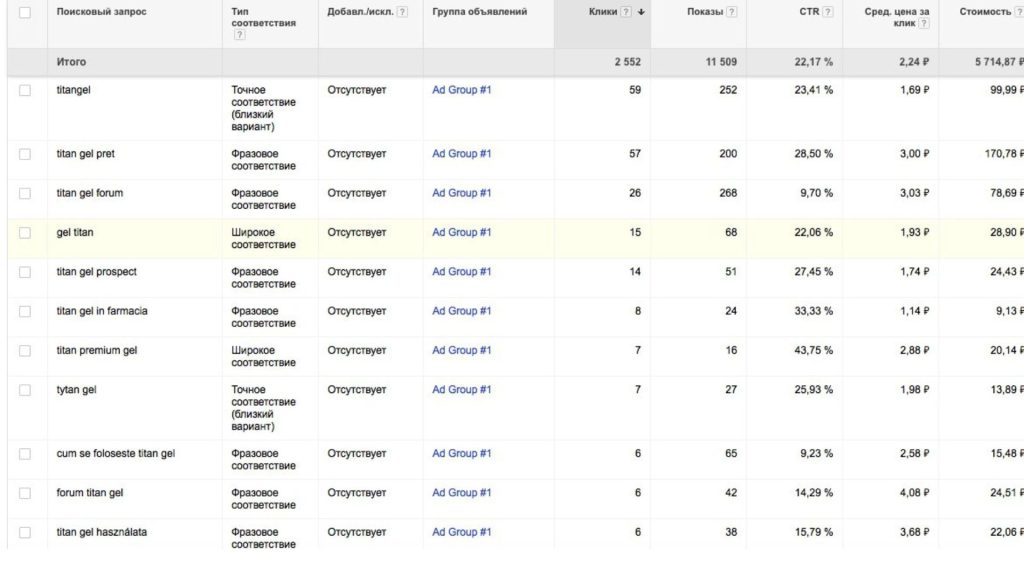
Where do you get all these traffic-driving search queries, though? Use keyword research tools like SEMRush or Similar Web (pro-access) to help conduct a list of relevant keywords for the offer.
Another highlight of creativeness here is the language display for these keys. All the ads are in Romanian to target users in this region, but the actual search key is still in English.
Thus, feel free to create an English keyword list. After that, use a translation tool to turn the creative into your needed language.
That way, your audience in Romania will still see the ads in their native language.
And regarding keyword bidding, it is the amount of money you can afford for your ad to rank for a specific keyword. Of course, top 1 results always get a much higher conversion rate.
So, the best strategy is to bid testing to get results. Then, you will adjust the bid to increase the chance of your ads showing up on top pages.
Specify Ad Position
Creating qualified and high-quality ads is one thing, but positioning them effectively is another. The first position on search engines will always enable better conversion rates, except for rare cases.
According to the tracker’s analysis, the first ad position had a 4.2% conversion rate in this case, while the second was 1.7%.
Thus, you should be willing to spend more money on ad positioning. Do not save money on click costs and place ads at lower positions.
Any type of physical item in AdWords can use this hint.
For your information, the common top ad positions are between 1 and 3.
This means they will constantly appear on the first search page, near the top of Google results. These ads are likely to yield more views and clicks from online customers.
Also, there are tips for displaying ads on different devices. Horizontal ads on the page’s top or bottom work best for mobile, while vertical on the screen’s left or right is for desktop.
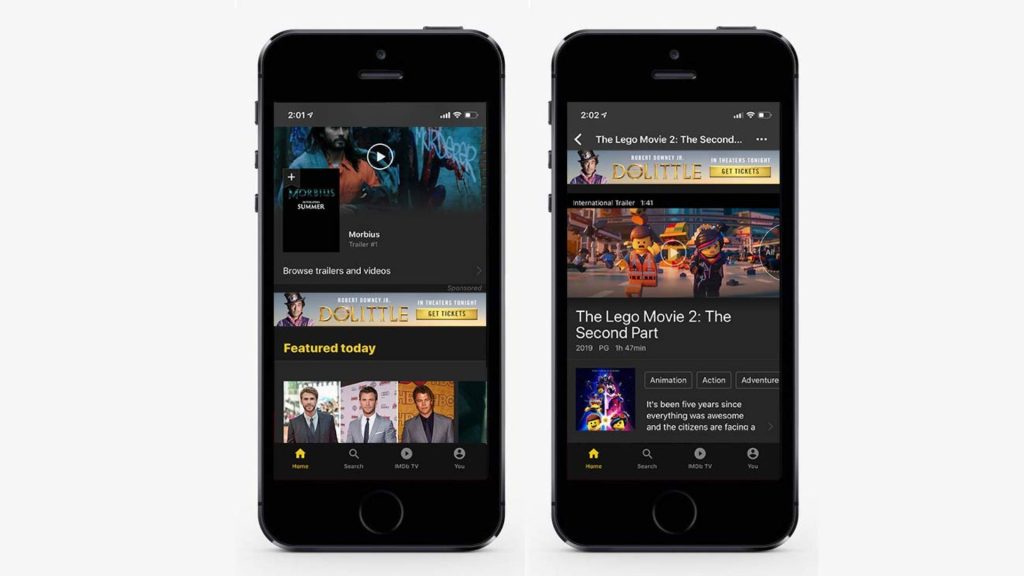
Don’t Be Discourage of Account Ban
AdWords bans promoting sex-related products, so you must apply the link-cloaking technique to market them.
When the ads are being checked, this link must be cloaked and hidden from a moderator. Then, you change the link, and everything goes back to normal.
Consequently, your accounts might be continuously banned during the experimental phase. Which is inevitable, so there is nothing to worry about.
That is why you have to continually create a series of new accounts to continue the work. Or have access to AdWords Ad Agency to run these new sign-ups successfully.
Understand that this is not a regular, mainstream niche. So your way to the top will also be different and more challenging than the others.
In case the link-cloaking does not work once and gets you suspended, get a new account and try it again. The more you test, the more you comprehend how the system works.
Test, Collect Data, Process For Insights, Then Retry
With each affiliate marketing case study until now, you can see that trial and error are necessary.
As mentioned above, it is perfectly alright to experiment with account bans. Do not be discouraged by a few initial setbacks.
In this case, Aynur had concluded that the accounts should be replenished with $12. Pouring big sums into your account is not wise for being banned right away.
They actually work well with a little money, though.
In July, there were 168 leads in total. Although half of them were rejected, this was still rather adequate.
Remember the budget-friendly expenses for traffic in this case to reach this incredible result!
Generally speaking, this case study conveys how a professional webmaster sees potential and is not afraid to push it further. There will be obstacles on the way, but he did not give up in the middle.
Instead, the affiliate marketer collected data and processed them for insights after each failure. After that, he tried again until he found the most sustainable tactic to keep an account running.
And this was only his ROI in Romania. Imagine all other possible regions to give it a shot!
Gaining $16k from Only One Product’s Commissions: Case Explained
Case Main Stats
From 2016 to 2021:
- Total clicks: 6,546
- Total sign-ups: 161
- Total revenue: $16,100
- Conversion rate: Approximately 2.5%
Honesty is The Best Policy
This affiliate marketing case study is solid proof that you can generate massive sales with one product. Anil Agrawal’s foundation for achieving this is being honest with your audience.
As new bloggers strive to make more affiliate sales, he notices that most lack honesty. Many begin their affiliate marketing journey with the “fake it til you make it” mindset.
Consequently, they share fake sales, traffic, income reports, etc., to drive attention to their social channels. So that it brings them more social proof to increase sales.
The truth is your audience can easily tell whether your numbers are fake. If they sense dishonesty, they will likely stop viewing your content, let alone generate sales.
Prioritize being transparent with your potential customers first.
Successful affiliate marketers like Neil Patel or Pat Flynn are famous for their honesty with readers. They always try to provide actual proof and experience to make real money online.
That is when they build trust with more and more people. Thus, they gain higher sales with amazing customer retention rates.
Helpful Content is a Must
In-depth product reviews
What can be better than writing appealing reviews to promote a product? And it is not just ANY random reviews but the genuine ones that bring value to your readers.
Most newbies in affiliate marketing produce reviews solely for commercial purposes. However, Anil’s advice is to at least experience the product before you recommend it to others.
If you are satisfied with it, write an unbiased and detailed review. Be careful in incorporating your personal opinions into the content while still marketing the item and its advantages.
Then, post the article on your website and promote the blog link on other social platforms.
Note that you should share the pros and cons to give audiences a clear overview. Interested customers will trust what you state and be willing to purchase.
Link building for said products
A backlink goes with an anchor text to link one website to another. Here is an example of a backlink, linking to another source outside the article:
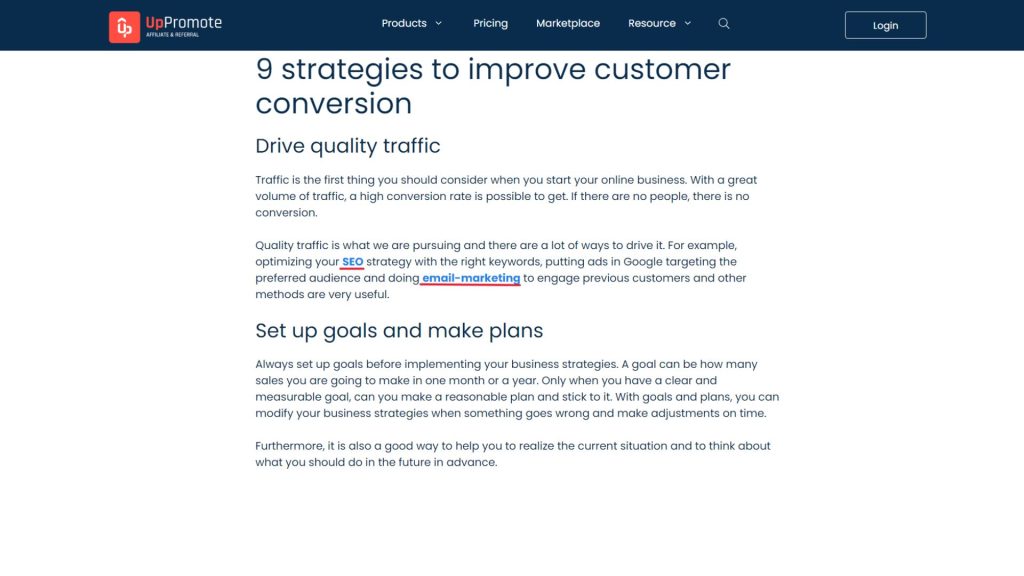
What is the use of link building for your affiliate goods?
If you want to get more traffic to increase sales, it requires high-quality backlinks. A potential buyer can see your promotional content with the link on one channel and then click on it to visit the product page.
In this case, the practice of search engine optimization (SEO) for your blog will be helpful. You can write informative blogs and insert affiliate links into relevant keywords.
Also, you can try the guest posting strategy. After writing a piece of content on another platform, you will promote the link to your website.
This is a smart way to build high-quality backlinks as your content is on high-authority websites. You can drive prospective leads to your original site content anytime.
Visible & accessible Ad banners
Building informative and valuable content is less effective if it cannot reach a broad audience. That is why you need to let people know about your offers via banner ads.
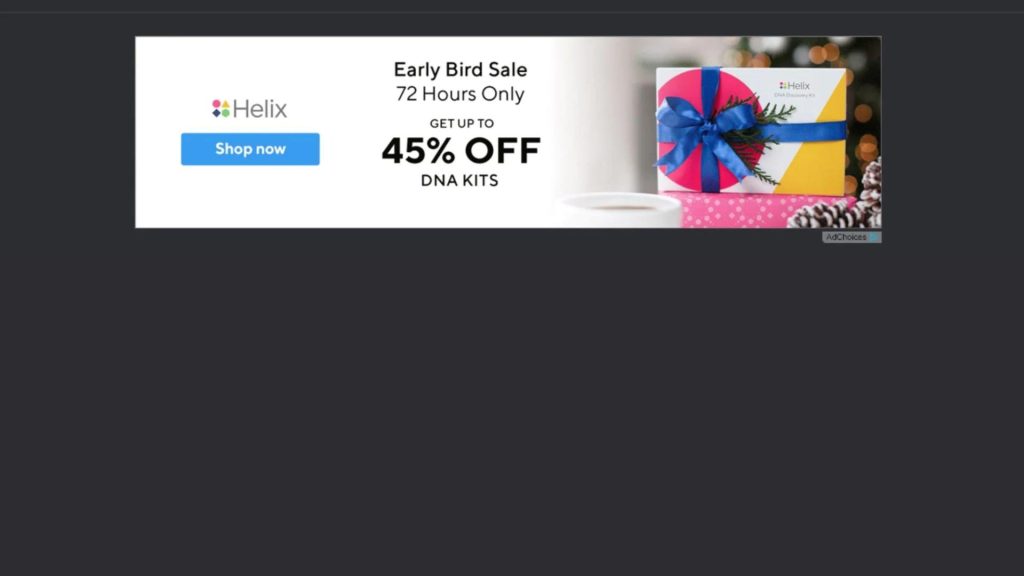
There are diverse positions to place the ad banners. For example, the page top, sidebar, full-screen pop-ups, etc.
Moreover, you should make it easy for website visitors to click on the banner.
Display clear CTAs to compel them to take action, like Shop now or Subscribe. Then, let the ads redirect them to your product page or an opt-in form.
The more visible and accessible your banners are, the more likely your traffic will click on them. Surprisingly, this source may contribute a large percentage of your income.
It’s Wise To Develop Lasting Relationships With Audiences
A successful affiliate marketing case study often requires the publisher to build strong relationships with their audiences. Cultivating trust will make your marketing efforts much more effective.
Here is how to develop audience trust towards your influencer marketing success:
Authenticity and value
The first and foremost rule to build trust is showcasing authenticity. Customers will believe in your words if you are transparent and genuine in your interactions.
Be honest about what you promote. And always remember to disclose your affiliations since some social media channels require it.
Regarding the content, bring what best benefits your audience to the table. It can be informational guides and blog posts or unbiased product reviews.
When customers find value from your sources, trust will grow.
Consistency and reliability
Omnichannel advertising is on the rise, so affiliate marketers will likely promote the same deal on multiple platforms. Thus, you should maintain a consistent branding style across these channels.
It will help the audience recognize and remember you among other content creators.
In addition to consistency, you should only market products you believe in and personally use. That way, your recommendations will align with your customer’s interests and needs.
Engagement and accessibility
Affiliate marketing is never a one-way street. When you receive input from social media audiences, make sure you respond to them.
This is especially important on forums like Quora or Reddit since they are mainly for discussions. Engage with your potential customers via post comments or during livestream sessions.
A major part of this is making yourself accessible online. Be available on social media or email so people know they can count on you for help if needed.
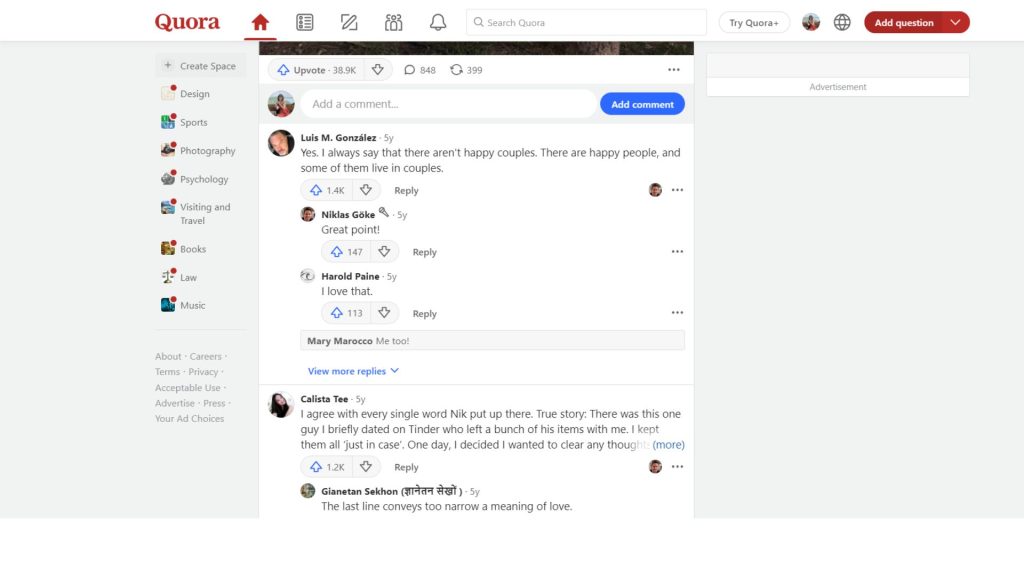
Deliver on promises
Underpromise and overdeliver. Sounds classic, but it still works wonderfully.
When you exceed your customer’s expectations, they will trust your suggestions more.
A side note: If your affiliate product has a money-back warranty, mention it. It creates a great image of thinking for your audience’s best interests.
Keywords Choosing Magic: Longtail Trumps Everything Else
One of the determining factors in getting traffic from search engines is finding the right keyword set.
Short-tail keywords are easy for marketers to find with a more popular search volume. Nonetheless, they do not specifically aim at your affiliate products.
For instance, searching for “noise-free laundry machine” on Google can yield multiple good results. However, this does not guarantee that your goods will appear at the top of the search among other options.
On the other hand, long-tail keywords can help you target niche demographics with less competition. Although they still belong to the same topic as short-tail counterparts, they represent specialized search queries (e.g., noise-free laundry machines for industrial use).
This makes way for high-quality traffic to visit your website. Plus, it helps your website content easily rank higher on search engines.
Follow these simple steps to discover your high-ranking long-tail keywords:
Build a product list in your niche
Assume you have not decided on any affiliate products yet. But you have already found your niche for affiliate marketing promotion, e.g., outdoor sports.
You can search for products being promoted on top blogs. Search for terms like “outdoor sports + top blogs” or “outdoor sports + best blogs” to find high-traffic, reliable blogs in your niche.
Find relevant long-tail keywords
You needn’t do this step manually. Apply online tools like SEMRush or Long Tail Pro for the best assistance.
With Long Tail Pro, enter keywords related to your products and hit Find Keywords.
It lets you choose the search volume of <1,000 monthly searches for higher Google ranks. Any product you wish to rank for is good to go.
Next, click Generate keywords & Fetch data. This feature gives you a list of relevant keywords to choose from, so pick 3-5 long-tails to add to your blog articles.
Promote your affiliate products
The last step is extremely crucial since this is where your sales come from.
If you can create awareness about the affiliate product, you will likely succeed in converting readers into buyers.
Keep in mind that making affiliate sales is not about placing links and banner ads everywhere. You must educate your blog readers about this item to generate more sales.
Conclusion
Each affiliate marketing case study here can be a fantastic example to inspire you to pursue affiliate marketing. They demonstrate that you can make a lot of money online with the right strategies alongside time and effort.
However, besides reading affiliate case studies, you need to take action in real life. These cases have explained how they reached the top despite limited resources, so why don’t you next?
Take what is best from each example and apply it to your affiliate marketing strategy. This could be your opportunity to start thinking outside the box and leverage the business.




